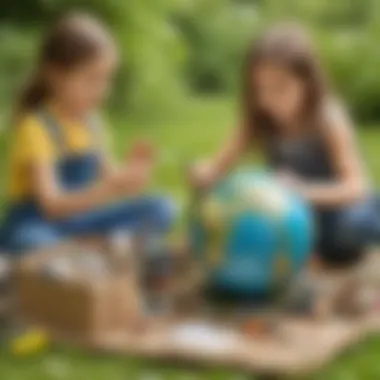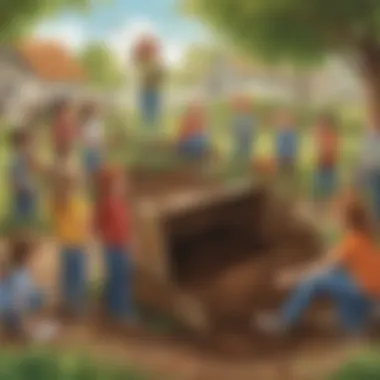Engage Your Kids with Earth Day Outdoor Activities: A Comprehensive Guide


Science Fun Facts
Earth Day is a celebration of our planet and a reminder of the importance of environmental conservation. Did you know that the first Earth Day was celebrated on April 22, 1970? It marked the birth of the modern environmental movement, led by Senator Gaylord Nelson. This day serves as an annual event to demonstrate support for environmental protection. The Earth's rotation actually slows slightly, and its axis shifts over time due to the gravitational pull of the Moon. This phenomenon, known as axial precession, affects the planet's climate and seasons, showcasing the intricate relationship between Earth and its celestial companions.
Discover the Wonders of Science
Now, let's delve into the wonders of science through engaging Earth Day outdoor activities for kids. Nature walks provide insight into ecosystems and biodiversity, fostering an understanding of the interconnectedness of living organisms. Through upcycling crafts, children explore the concept of sustainability and creative reuse, learning how everyday items can be transformed into new treasures. Interactive learning tools such as nature identification apps and educational videos on environmental issues offer a dynamic way to enhance children's scientific knowledge. Real-life applications of science come to life as kids witness the impact of human actions on the environment and discover ways to contribute positively through small changes in their daily lives.
Science Quiz Time
Challenge young minds with fun and interactive Earth Day quizzes! Test knowledge on environmental concepts, wildlife conservation, and sustainable practices through multiple-choice questions and brain teasers. Encourage critical thinking and problem-solving skills by presenting thought-provoking scenarios related to climate change, recycling, and energy conservation. Learning becomes gamified through engaging puzzles that prompt children to think creatively while gaining insights into ecological principles. Quizzes not only assess understanding but also inspire curiosity and a lifelong passion for environmental stewardship.
Science Experiment Showcase
Embark on a scientific journey with exciting Earth Day experiments for kids. From creating miniature ecosystems in jars to investigating water pollution through filtration experiments, hands-on activities offer an immersive way to learn about environmental science. Step-by-step instructions guide young scientists through each experiment, emphasizing safety tips and precautions to ensure a learning experience that is both educational and secure. Experiment materials such as recycled materials, soil samples, and testing kits provide tangible resources for children to explore scientific concepts while fostering a sense of environmental responsibility.
Introduction to Earth Day
Earth Day serves as a crucial reminder of the significance of environmental conservation and sustainability. This section delves into the essence of Earth Day, emphasizing its role as a global initiative to promote awareness and action towards protecting our planet. For children aged 6-12, understanding the origins and purposes of Earth Day can lay a solid foundation for their environmental consciousness. It provides a platform to educate youngsters on the importance of respecting nature, reducing waste, and embracing eco-friendly practices in their daily lives.
By introducing children to the concept of Earth Day, we aim to instill in them a sense of responsibility towards preserving the environment for future generations. This introduction sets the stage for engaging outdoor activities that not only entertain but also enlighten kids on the interconnectedness of all living beings and the delicate balance of the ecosystem. Therefore, the enlightened motivation behind celebrating Earth Day acts as a catalyst for cultivating environmental stewardship and fostering a profound connection to the natural world.


Furthermore, immersing children in the ethos of Earth Day empowers them to become change-makers in their communities. It encourages them to explore innovative ways to protect the environment, such as reducing carbon footprints, promoting sustainability, and embracing green technologies. This proactive approach towards environmental advocacy equips young minds with the knowledge and enthusiasm to make a positive impact on the planet, reinforcing the core values of Earth Day throughout their formative years.
In essence, this section underscores the pivotal role of Earth Day in shaping children's environmental awareness and underscores the guiding principles behind this global movement. By elucidating the significance of Earth Day, we pave the way for meaningful outdoor activities that not only entertain but also educate, nurturing a generation of eco-conscious individuals committed to safeguarding our Earth.
Outdoor Activities for Earth Day
Earth Day is a significant occasion that calls for heightened awareness and appreciation of our planet's natural beauty. In this article, we will delve into various outdoor activities tailored for kids aged 6-12, aiming to spark curiosity and instill eco-conscious behaviors for the future. These activities serve as invaluable tools for nurturing a sense of environmental responsibility at a young age, fostering a deep connection with nature, and promoting experiential learning that transcends traditional classroom settings.
Nature Walks and Scavenger Hunts
Nature walks and scavenger hunts are immersive experiences that allow children to engage with their surroundings actively. Encouraging kids to explore outdoor environments, observe wildlife, and collect natural treasures not only enhances their scientific knowledge but also promotes physical activity and sensory stimulation. Nature walks provide opportunities for hands-on learning, introducing children to diverse ecosystems, plant species, and animal habitats. Meanwhile, scavenger hunts stimulate problem-solving skills and foster teamwork among participants, making the learning process engaging and interactive.
Planting Trees and Gardening
Planting trees and engaging in gardening activities are practical ways to impart essential lessons on environmental conservation and sustainable living. By actively participating in tree-planting initiatives, children learn about the importance of trees in mitigating climate change, supporting biodiversity, and enhancing air quality. Gardening fosters a sense of responsibility and patience as kids nurture plants from seeds to fully grown specimens, teaching vital concepts of growth cycles, soil health, and organic practices. These activities not only beautify outdoor spaces but also instill a sense of accomplishment and environmental stewardship in young minds.
Bird Watching and Wildlife Observations
Bird watching and observing wildlife offer children insights into the rich diversity of species that inhabit our planet. By learning to identify birds, mammals, reptiles, and insects in their natural habitats, kids develop a deeper appreciation for biodiversity and ecological balance. Encouraging curiosity and empathy towards animals, bird watching sessions instill respect for wildlife and provide opportunities for scientific inquiry. Wildlife observations foster conservation values, nurturing a sense of responsibility towards protecting natural habitats and endangered species.
Water Conservation Projects


Water conservation projects are instrumental in educating children about the preciousness of water resources and the importance of sustainable usage. Through interactive activities like building rainwater harvesting systems, creating water filtration models, or organizing beach clean-ups, kids learn about water cycles, pollution prevention, and the impact of human activities on aquatic ecosystems. These projects raise awareness about global water scarcity issues, prompting eco-conscious behaviors such as reducing water waste, conserving freshwater sources, and advocating for clean water initiatives in communities.
Nature Crafts and Eco-friendly DIYs
Engaging in nature crafts and eco-friendly do-it-yourself (DIY) projects nurtures children's creativity while reinforcing environmental values. From upcycling household items to creating biodegradable art pieces, these activities encourage resourcefulness, innovation, and waste reduction. By repurposing materials and incorporating sustainable practices into art and design, kids learn about recycling, reducing carbon footprints, and promoting a circular economy. Nature crafts and eco-friendly DIYs foster a sense of innovation and conservation, empowering children to become mindful consumers and eco-conscious advocates in their daily lives.
Learning About Sustainability
In this section, we delve into the critical topic of sustainability, an essential theme in today's world. Sustainability is about meeting our current needs without compromising the ability of future generations to meet their own needs. It's vital for children to grasp the concept of sustainability from a young age to ensure a harmonious coexistence with the planet. By understanding sustainability, kids can develop a sense of responsibility towards the environment, learning how their actions impact the world around them. This knowledge empowers them to make informed choices that contribute to a more sustainable future.
Understanding Recycling and Composting
Recycling and composting are two fundamental practices that play a significant role in sustainability. Recycling involves turning waste items into new products to prevent the overuse of raw materials and minimize waste in landfills. Kids can learn about the importance of sorting recyclables, such as paper, plastic, and glass, and how these materials can be processed and transformed into new products. Composting, on the other hand, involves turning organic waste into nutrient-rich soil to enrich gardens and reduce the reliance on chemical fertilizers. Children can understand the concept of biodegradability and witness firsthand how food scraps and yard waste can naturally decompose into compost that benefits plant growth.
Exploring Renewable Energy Sources
Renewable energy sources are an integral part of sustainability, offering clean alternatives to traditional fossil fuels. By exploring renewable energy sources like solar, wind, and hydroelectric power, kids can appreciate the importance of harnessing energy from natural, replenishable sources. They can understand how solar panels convert sunlight into electricity, how wind turbines generate power from the wind's kinetic energy, and how hydroelectric plants utilize the force of flowing water to produce electricity. Learning about renewable energy sources encourages children to consider eco-friendly energy options and advocate for a greener, more sustainable future.
Interactive Workshops and Educational Sessions
In the realm of Earth Day celebrations for young minds, the incorporation of interactive workshops and educational sessions plays a pivotal role. These sessions act as the bridge between theoretical environmental knowledge and practical application, offering children a hands-on approach to understanding sustainability concepts. By immersing participants in dynamic activities and discussions, these workshops cultivate inquisitiveness and critical thinking skills regarding ecological issues.


One significant benefit of interactive workshops is their ability to engage children on a personal level, fostering a sense of responsibility towards the environment. Through immersive experiences like simulating renewable energy processes or waste management scenarios, youngsters grasp complex ecological concepts in a relatable manner. These sessions not only educate but also empower kids to become proactive agents of positive change in their surroundings.
Moreover, interactive workshops and educational sessions provide a platform for holistic learning, integrating various subjects like science, technology, engineering, arts, and mathematics (STEAM). By intertwining environmental lessons with interdisciplinary activities, children develop a broader understanding of sustainability and its interconnectedness with different fields of study.
In planning such workshops, considerations must be made to ensure age-appropriate content, interactive materials, and a balance between fun and educational elements. The activities should be designed to stimulate curiosity, encourage teamwork, and inspire creativity, fostering a conducive learning environment for young participants. By tailoring these sessions to cater to different learning styles and preferences, educators can ensure maximum engagement and knowledge retention among children.
Benefits of Engaging in Earth Day Activities
As we delve into the realm of Earth Day activities, it is crucial to understand the myriad benefits that come with engaging in these eco-conscious endeavors. Earth Day activities serve as a catalyst for instilling a sense of environmental stewardship and sustainability in young minds. By actively participating in these activities, children aged 6-12 can develop a profound appreciation for nature and the interconnectedness of all living organisms. Through hands-on experiences like nature walks, tree planting, and wildlife observations, kids can witness firsthand the importance of preserving our planet's delicate ecosystems.
Moreover, Earth Day activities offer a unique opportunity for children to cultivate essential skills such as teamwork, problem-solving, and creativity. Engaging in projects like water conservation initiatives and eco-friendly DIY crafts encourages kids to think critically about environmental issues and brainstorm innovative solutions. These activities not only foster cognitive development but also nurture a sense of responsibility towards the planet and future generations.
In addition to the intellectual and emotional growth fostered by Earth Day activities, physical benefits are also abundant. Spending time outdoors, whether tending to a community garden or participating in nature-inspired art projects, promotes physical well-being and fosters a deeper connection to the natural world. The hands-on nature of these activities encourages movement, leading to improved motor skills and overall health.
Furthermore, participating in Earth Day activities instills a sense of accomplishment and pride in children as they witness the positive impact of their actions on the environment. By actively contributing to sustainability efforts, kids develop a sense of agency and empowerment, recognizing that their small actions can collectively make a significant difference. This sense of efficacy instills a lifelong commitment to environmental conservation and serves as a foundation for becoming responsible global citizens.
Conclusion
In the realm of Earth Day outdoor activities for kids, the conclusion serves as the cumulative realization of the significance of these engaging and educational experiences. Through participating in nature walks, scavenger hunts, tree planting, gardening, bird watching, wildlife observations, water conservation projects, and eco-friendly crafts, children aged 6-12 embark on a journey of exploration, learning, and environmental stewardship.
One of the paramount elements to consider in this concluding section is the lasting impact these activities can have on children's development. Engaging in such outdoor pursuits not only fosters a deeper connection to nature but also nurtures essential skills such as observation, critical thinking, and creativity. By immersing in hands-on activities like planting trees or crafting with recycled materials, youngsters not only learn about environmental conservation but also cultivate a sense of responsibility towards the planet.
Moreover, the benefits derived from Earth Day activities extend beyond individual growth. As children partake in these communal endeavors, they learn the value of teamwork, collaboration, and collective action in addressing environmental issues. This sense of collective responsibility instilled during Earth Day celebrations can have a ripple effect, inspiring families, schools, and communities to adopt sustainable practices and advocate for a greener future.
Furthermore, in today's technocentric society, where screen time often surpasses outdoor play, Earth Day activities offer a much-needed reprieve. By encouraging children to step outdoors, explore the natural world, and engage in tactile experiences, these initiatives promote physical activity, sensory stimulation, and overall well-being. Connecting with nature not only nurtures children's mental and emotional health but also instills in them a sense of wonder and curiosity about the world around them.
Conclusively, the essence of Earth Day outdoor activities lies in their transformative potential. As children delve into the realms of sustainability, conservation, and environmental awareness through hands-on practices and immersive experiences, they not only enrich their own lives but also contribute to the collective efforts of building a more sustainable and harmonious future for generations to come.







